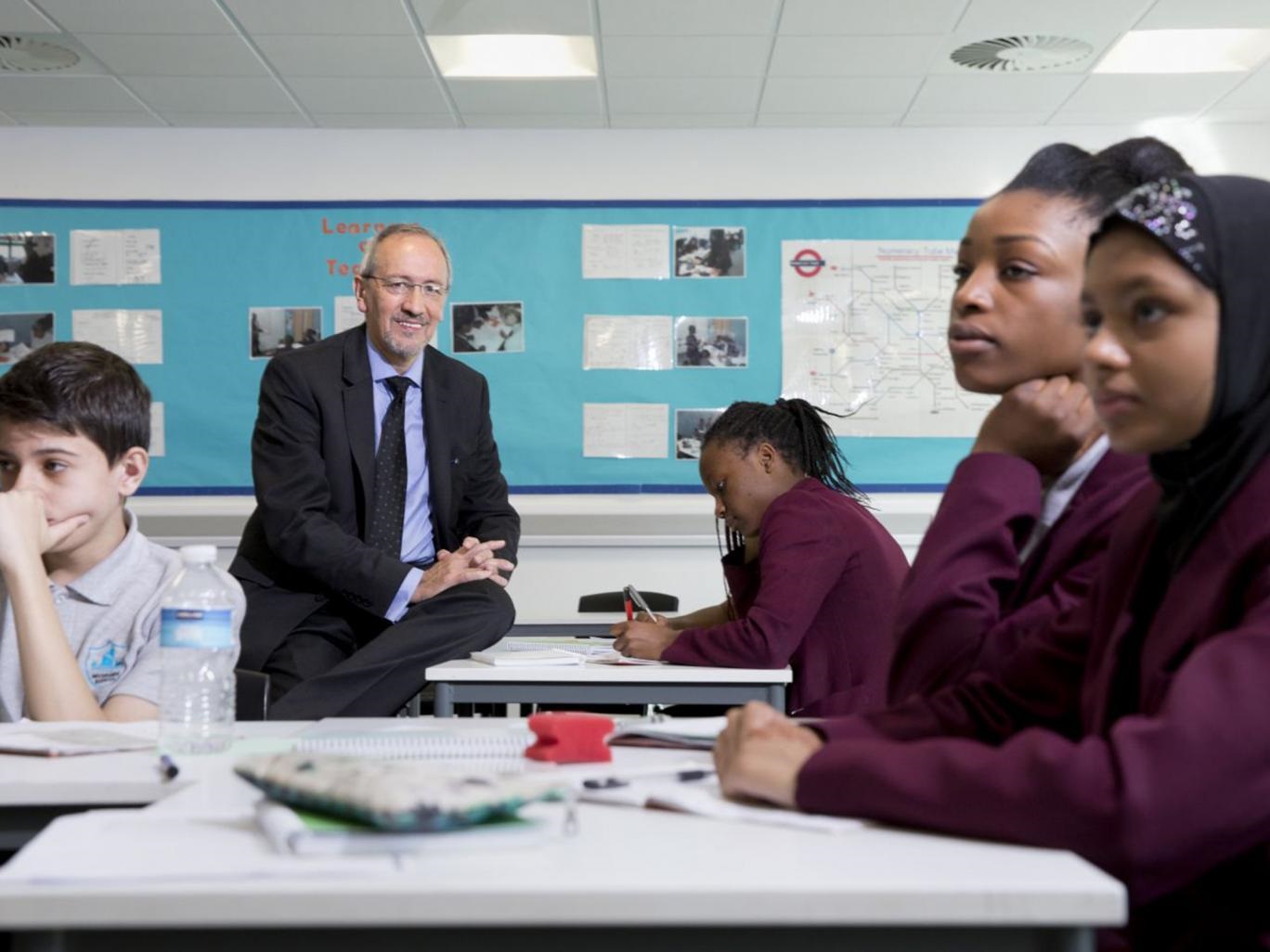Free schools: Three-in-one approach to education is a sign of things to come

Free and easy: Head teacher Roger Leighton with Year 10 maths pupils at Riverside School in Barking, Essex Teri Pengilley
Visit the Riverside Campus in Barking and Dagenham and you get three free schools for the price of one. The site houses Riverside Primary School, the secondary Riverside School, and Riverside Bridge School – which caters for special needs pupils – all on the same campus.
It is a sign of things to come, as growing numbers of free schools and academies express support for a similar type of arrangement.
At Riverside, all you have to do is step through a doorway to move seamlessly from one school to another. The scheme, introduced by Partnership Learning – the trust which runs the school – first of all eliminates the fear of moving from primary to “big” school as pupils simply shift along the corridor.
In addition, as has happened in the case of at least one pupil at Riverside, a secondary school student who struggles in some areas can receive special-needs help on the site – while still accessing the mainstream school for some subjects.
The free school project was initiated by the last government, but the origins of the Riverside project are considerably older. It was all set to be up and running under the previous Labour administration when the axe fell on the scheme.
“The need was identified a long time ago – six or seven years ago, in fact,” said Roger Leighton, chief executive of Partnership Learning. “Then the new government [the coalition] came in and the free school movement came with it,” says Mr Leighton. “[It] seemed the best way to take our dream forward.”
It wasn’t all plain sailing. The group’s first application was turned down. “We’re not an unmitigated success story,” says Mr Leighton. However, the secondary school got the green light the second time around – and has now been operating for four years, with 120 students in each year group. Ultimately, it will grow until it has 1,800 pupils.
The primary school and special needs school – called Riverside Bridge because it can also act as a “bridge” between special needs and mainstream pupils – have just opened. The primary school at present has only one reception class, with 24 pupils. Eventually, it will have 630 pupils and Riverside Bridge, 180.
As with almost all free school projects, the institution has some unique features that mark it out as different. For a start, there is no mixed-ability teaching – pupils are placed in ability bands in the secondary school based on their previous performance.
“There is a supported pathway, a standard pathway and an accelerated pathway,” says Mr Leighton. “There is movement between these bands of ability,” he added. So, if a child shows promise, they can switch.
The accelerated band tutor groups will typically have 30 pupils in them and “10 or 11 specialist subject teachers”, says Mr Leighton. “They need to be stretched and challenged.”
The supported pathway, likely to have just 14 or 15 pupils, will concentrate more on developing numeracy and literacy skills. “They need 24/7 support. It means you only ever have lessons with other students of your own ability and means you don’t have pupils worried about falling behind because other pupils are moving on at a faster pace. Also, there are fewer constraints about other pupils being challenged and stretched.”
The secondary school believes it is already beginning to see the first seeds of success from this initiative. This summer, the majority of its year nine students [first year GCSE] were put in for science exams a year early. Of the 62 per cent of the age cohort who took the exam early, there was 100 per cent success in getting A* to C grades, with 68 per cent of those getting A* to B and 27 per cent A* or A grade passes, significantly above the national average.
The ban on mixed-ability teaching is also set to filter down to the primary school. Once it is up and running at its full potential, children will be put into different ability bands for their last three years – from the age of eight – and this may even be extended to the last four years.
Mr Leighton believes this approach is quite rare, since in most primary schools that have adopted a form of banding they will only put children in different sets for maths and English, rather than the curriculum as a whole.
Another innovative feature of the schools is that the plan is to recruit only newly qualified teachers (NQTs) – except, of course, for the headteachers. “We wanted to attract really ambitious young teachers,” explains Mr Leighton. It also means the schools can appoint the pick of the NQTs who have done their training at the Sidney Russell School, an academy also run under the Partnership Learning umbrella and designated to train new recruits.
The project is already expanding – Sidney Russell is acting as sponsor for a failed primary school in the area – and those behind the trust are coming under pressure to help improve schools across the country.
London has been the success story of the past two decades in terms of raising standards – a rise not followed elsewhere in the country.
The Department for Education is keen to persuade multi-agency trusts that have proved successful to take on as many schools as they can manage and ministers are keen to promote the idea of all-through education on one site.
The concept of the three-in-one free school could soon be emerging in an area like yours.
credit : http://www.independent.co.uk/news/education/education-news/free-schools-three-in-one-approach-to-education-could-be-sign-of-things-to-come-a6725821.html